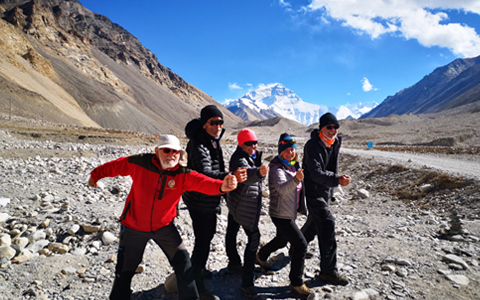The Tibet train runs on the world’s highest railway, Qinghai-Tibet Railway, which has an average altitude of over 4000 meters. In most areas along the route, the oxygen level is only 50% to 60% of that found in mainland China. Such high elevations and low oxygen levels can lead to altitude sickness for some passengers.
To help reduce the risk of altitude sickness, the Tibet trains are all specially designed with oxygen supply systems. Read this guide to know details about Tibet train’s oxygen supply, when and how to use it, and more tips for a comfortable train journey.
Is Oxygen Supply Available on Tibet Train? Yes, Two Systems Available
Tibet trains are all equipped with the oxygen supply systems to provide better train experience. There are two kinds of oxygen supply systems on Tibet trains, which can keep the required oxygen level in the train and help passengers better deal with altitude sickness.
One is the “dispersion-mode” oxygen supply system, which spreads oxygen made by the oxygen generator to the whole carriage via the air-conditioning system. Oxygen is pumped in when the train reaches the higher altitudes, to maintain the oxygen content of the air at about 23%.
 Tibet trains are all equipped with the oxygen supply systems to provide better train experience.
Tibet trains are all equipped with the oxygen supply systems to provide better train experience.The other is the independent system, which can be directly used by passengers through the individual oxygen outlets. These oxygen outlets are easily be found, as they are marked with the words “OXYGEN OUTLET”.
In the soft sleeper cabin and hard sleeper cabin, the oxygen outlets are near the beds and can be used while lying down. In hard seat carriage, you can easily find them beneath the seats. In the train corridor, oxygen supply outlets are on the train walls.
Join our Tibet train tour for a smooth travel experience!
When to Use the Oxygen Supply during My Tibet Train Journey?
The oxygen supply system does not convey oxygen for the entire train trip to Tibet. When the train passes Golmud Railway Station (2829 meters), the oxygen supply system will be switched on, delivering fresh and refreshing oxygen into the carriage. When the oxygen supply systems are working, smoking is forbidden in all the carriages.
For passengers, if you suffer from symptoms of altitude sickness, you can use the individual oxygen supply on the Tibet train. The altitude sickness is a common disease unique to the plateau, due to the low-pressure and low-oxygen environment. No matter how age, sex or physical fitness you are, you may experience altitude sickness.
 Passengers can use the individual oxygen supply when suffer from altitude sickness.
Passengers can use the individual oxygen supply when suffer from altitude sickness.The symptoms of altitude sickness include headache, insomnia, loss of appetite, fatigue, difficulty breathing, etc. Headaches are the most common symptom, and pain is aggravated at night or in the morning. If you shows any of these symptoms, you should use the private oxygen supply to relief yourself.
How to Use the Oxygen Supply on Tibet Trains?
Don’t worry, the private oxygen supply system on the Tibet train is very simple to use. It is free for all classes of passengers travelling on the Tibet train.
Usually, the trainman will distribute the disposable tubes to passengers as the train approaches Golmud. The disposable tube comes in a plastic bag and is used to connect the oxygen supply outlet to your nose. You can also ask for it when you suffer from altitude sickness.
First, tear open this bag and get the tube out, then connect one end of the tube to the oxygen outlet. There are two small tubes at the other end of the tube. You just need to insert these two small tubes into your nostrils.
You do not need to press any button to let oxygen come out from the outlet. Once the tube is inserted into your nostrils, you can breathe the oxygen freely.
Experience the unique Tibet train journey by joining our well-designed route!
What If I Still Suffer Altitude Sickness After Using Oxygen Supply on Tibet Train?
Though the Qinghai-Tibet Train has two kinds of oxygen supply systems, that does not mean every passenger can safely go through the entire train journey, without any high altitude concern. Some may still feel uncomfortable or even suffer from severe altitude sickness after using the oxygen supply. In this occasion, you can ask for the medical services from the trainman.
The fact is, every Tibet train to or from Lhasa is equipped with experienced doctors and trained nurses, and they are available to deal with medical emergencies. So, when the oxygen supply does not work for your situation, you can receive timely and effective first aid from medical service on the Tibet train as well.
 Medical service is available on Tibet train.
Medical service is available on Tibet train.One thing to be noted: the Golmud to Lhasa section is where one may experience altitude sickness. The highest station on the Tibet train journey, Tanggula Station (5068 meters), is the most likely place to experience altitude sickness. When the train is ready to pass through these higher-altitude areas, you are advised to pay extra attention to the issue of altitude sickness.
More Tips for a Comfortable Tibet Train Experience
1. The best way to avoid or reduce altitude sickness is to maintain a good mood, as many symptoms are influenced by the mentality. Do not be nervous; you can listen to music or appreciate the spectacular landscape along the railway.
2. The aisles on the Tibet train are relatively narrow, so avoid walking fast or running, especially when passing through high-altitude areas. Ensure adequate sleep and rest, since good rest helps your body adapt to the plateau as soon as possible.
3. Hot water is provided on the train. Drinking plenty of water can soothe both your mind and body, and it also helps drive away the chill. When your body and mind are comfortable, altitude sickness is less likely to affect you.
4. Although there are air conditioners on the train, it is necessary to adjust your clothing as needed to avoid catching a cold. Catching a cold can be dangerous at high altitudes. You should bring some cold medicine and other necessary medicine for your Tibet train trip.
Join our Tibet train tours for a hassle-free experience.
Conclusion
There are two oxygen supply systems on the Tibet train to provide oxygen for passengers. In most cases, you can have a relatively pleasant Tibet train journey with the help of oxygen supply. Even if you experience altitude sickness or other physical problem, you can ask the doctor or the trainman for help immediately.
If you still have any question about taking Tibet train, feel free to contact us. We are always here to ensure you have a seamless and worry-free trip to Tibet.

























 Tibet trains are all equipped with the oxygen supply systems to provide better train experience.
Tibet trains are all equipped with the oxygen supply systems to provide better train experience.
 Passengers can use the individual oxygen supply when suffer from altitude sickness.
Passengers can use the individual oxygen supply when suffer from altitude sickness. Medical service is available on Tibet train.
Medical service is available on Tibet train.







Ask a Quick Question